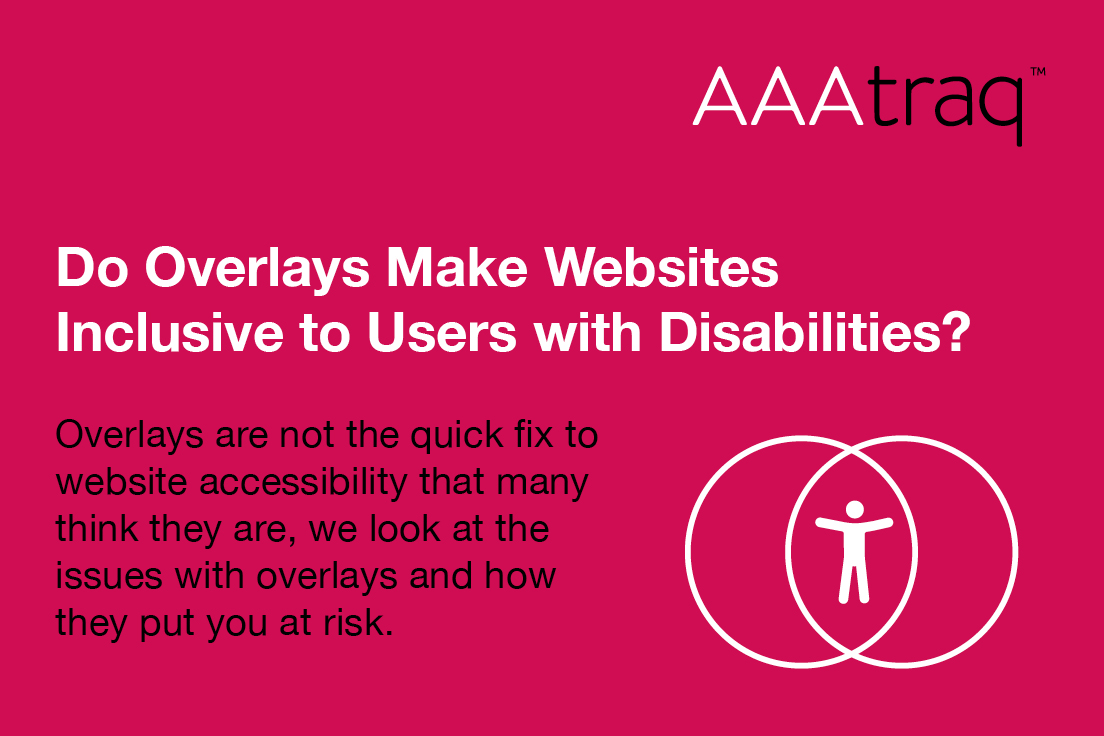Do Overlays Make Websites Inclusive to Users with Disabilities?
Jun 01 2022
The simple answer: no! Widgets, as defined by the World Wide Web Consortium (W3C), are a “discrete user interface object with which the user can interact.” Widgets, and overlays, whose use is almost synonymous with that of the widget, engage with aspects of the website in the attempt to make it more user friendly and inclusive.
In theory, website operators think they are utilizing these widgets/overlays on their website as a mechanism for actively avoiding web inaccessibility. While the creators of these technologies often make promises of web accessibility compliance, these promises are veiled by knowledge that their technology is just a bandage for the issue and does not sufficiently remedy accessibility concerns. Often, it makes web accessibility issues worse, and overlays are a target for drive by lawyers, leading to more lawsuits.
When assessing for potential success in a litigious action, most plaintiff firms use web accessibility scanning tools to look at websites as potential targets of lawsuits. Most of the prominent accessibility scanning tools, reveal accessibility failures in the website’s code. Widgets only attempt to correct part of the problem, as they apply a script to the page which scans the code and automatically try to address the problem (sometimes making it worse). The truth is lawsuits don’t always site Web Content Accessibility Guidelines (WCAG) failures (the perceived norm in web accessibility failures) in their actions. More often, now, plaintiffs illustrate the discriminatory behavior of website owners by referring to the functional issues associated with web inaccessibility. In many lawsuits, the functional issues pointed to in complaints affect visually impaired users, but not all. Widgets/Overlays are offered to businesses as “quick fixes” to problems they may not want to deal with. Don’t be fooled by this veiled promise: what is really happening is you’re just giving another plaintiff grounds for suit.
In 2020, over 250 lawsuits were filed against websites who were making use of an accessibility widget/overlay.1 At least 5 different accessibility products were included in complaints (including AccessiBe, UserWay, and AudioEye). Though each of these companies insist that they are providing you peace of mind with their tool, however, they’re just leaving you exposed to litigation. These tools aim to interact with users who may have no ability to interact with them. UserWay, features the logos and names of 46 prominent clients on their website. Of those 46, 7 client websites (15.23%) have been sued for website inaccessibility.2 The more the companies who sell widgets spin the idea that they are providing more security against litigation, the more complacent (and subsequently vulnerable) a company becomes. For instance, the city of Bettendorf, Iowa, recently designed an “accessible” website using UserWay as their overlay. After the remodeling, we at AAAtraq assessed the website’s risk, and identified it as Very High Risk.
Many in the community who make use of the accessibility features of a website agree: overlays and widgets aren’t enough. They don’t solve your website compliance issues. Advocates and consultants within the community, such as Karl Groves and Adrian Roselli, have demonstrated that these tools make matters worse. By not engaging with the website from a functionality perspective widgets/overlays lack the ability to make a meaningful impact on the user experience (a key component in avoiding litigation). Website features interact with these tools differently and may cause greater concern for users (such as ad blockers may nullify the effect of a widget, as the tool would be imperceptible to the user). Issues such as contrast, and proper alt-text are rarely addressed appropriately and may even be exacerbated.
In lieu of using a widget/overlay that won’t work, take a first step to understand your risk. It’s free and it’s easy to use (taking under a minute), head to AAAtraq.com and enter your web’s address. It’s not too late to head off the next lawsuit.
1 Jason Taylor, “A Record-Breaking Year for ADA Digital Accessibility Lawsuits,” A Record-Breaking Year for ADA Digital Accessibility Lawsuits, December 21, 2020, https://blog.usablenet.com/a-record-breaking-year-for-ada-digital-accessibility-lawsuits (opens in a new window)
2 Only one is known to have been dismissed in favor of their client. UserWay Inc., “The World's #1 AI-Powered Web Accessibility Solution ENSURES WCAG & ADA Compliance,” The World's #1 AI-Powered Web Accessibility Solution Ensures WCAG & ADA compliance. UserWay® Website Accessibility., accessed March 21, 2022, https://userway.org/?utm_source=adwords (opens in a new window)
Subscribe to AAAtraq and enjoy complete cover and peace of mind
